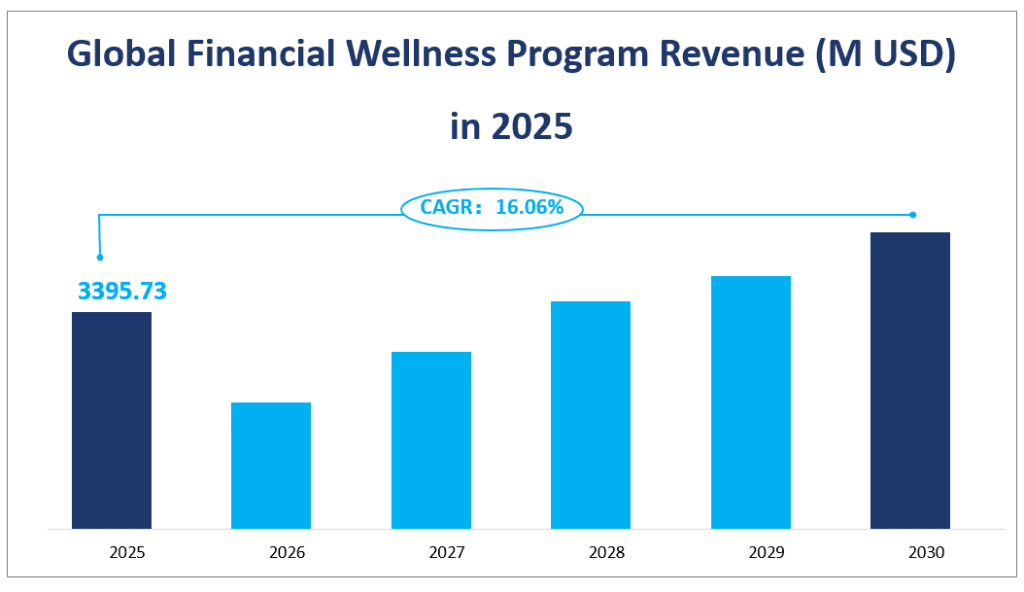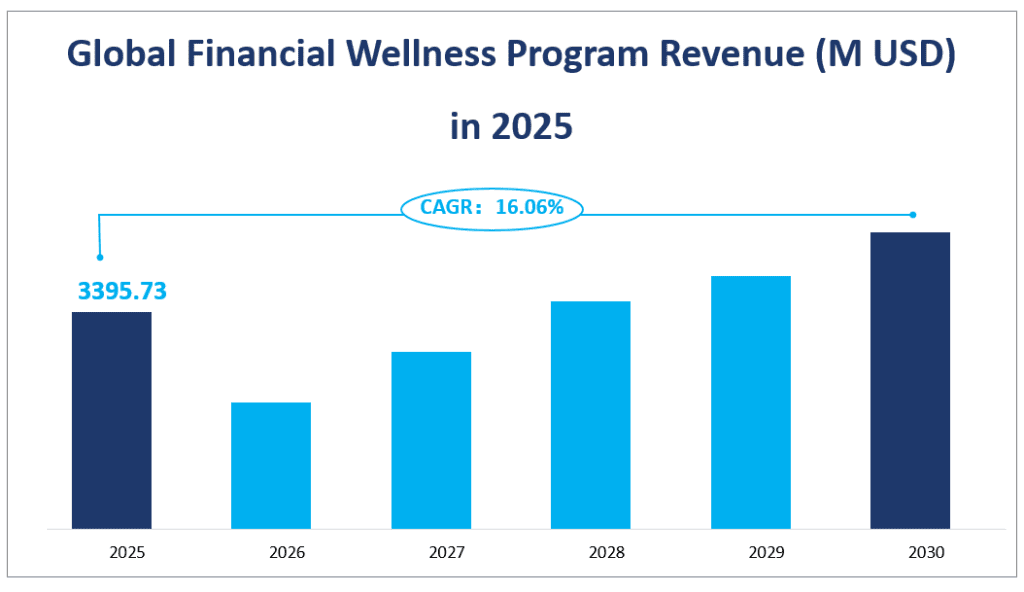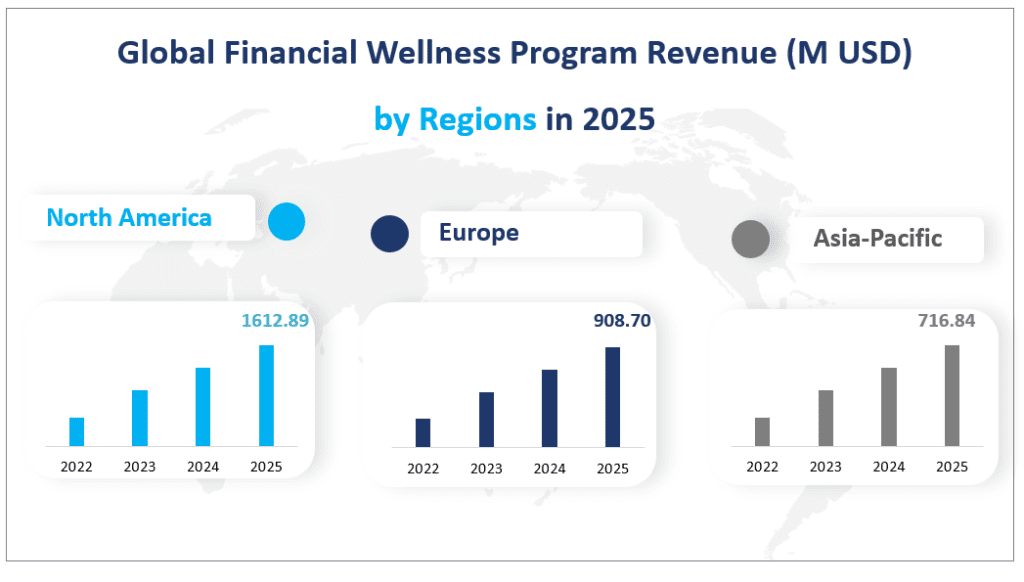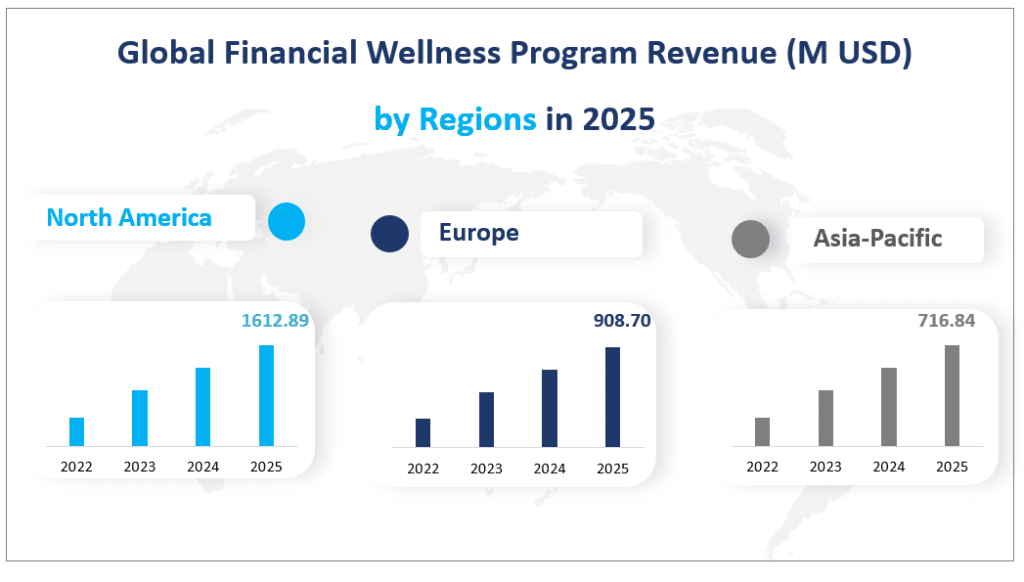1. Global Financial Wellness Program Projections
The global Financial Wellness Program market is projected to reach a revenue of $3,395.73 million in 2025 with a CAGR of 16.06% from 2025 to 2030.
A Financial Wellness Program is designed to educate individuals about personal financial risks, such as loss of income due to illness or unexpected medical expenses, and provides tools to manage these risks effectively. These programs are essential in today’s complex financial landscape, where individuals face numerous financial challenges, including debt management, retirement planning, and budgeting. Financial wellness programs aim to enhance financial literacy, reduce financial stress, and promote long-term financial stability. Employers are increasingly adopting them as part of their employee benefits packages to improve job satisfaction, productivity, and employee retention. By providing employees with access to financial education and resources, companies can create a more engaged and financially secure workforce.
Global Financial Wellness Program Revenue (M USD) in 2025


2. Driving Factors of the Financial Wellness Program Market
Firstly, the increasing complexity of personal finance has led to a greater demand for financial education and support. With rising debt levels, volatile financial markets, and the need for long-term financial planning, individuals are seeking guidance to manage their finances effectively. Financial wellness programs offer personalized solutions that can help individuals navigate these challenges and achieve their financial goals.
Secondly, the shift towards remote work and digital solutions has accelerated the adoption of financial wellness programs. The COVID-19 pandemic has highlighted the importance of financial resilience and has driven many companies to invest in digital tools and platforms that support employee well-being. Financial wellness programs, which can be accessed online, have become an essential component of these digital solutions, providing employees with the flexibility to manage their finances from anywhere.
Thirdly, the growing awareness of the link between financial stress and employee productivity has prompted many employers to prioritize financial wellness. Studies have shown that employees who are financially stressed are less productive, more likely to miss work, and have higher healthcare costs. By offering financial wellness programs, employers can improve employee engagement, reduce turnover, and enhance overall organizational performance.
3. Limiting Factors of Financial Wellness Program Market
Despite the significant growth potential, the Financial Wellness Program market also faces several challenges. One of the primary limiting factors is the lack of widespread awareness and understanding of financial wellness programs. Many individuals and companies are still unfamiliar with the concept and benefits of these programs, which can hinder market penetration. Effective marketing and education efforts are needed to raise awareness and demonstrate the value of financial wellness programs.
Another challenge is the high dependency on technology and data integration, which can pose security risks. Financial wellness programs often involve the collection and analysis of sensitive personal and financial data. Ensuring the security and privacy of this data is crucial to building trust and maintaining user confidence. Companies must invest in robust cybersecurity measures to protect against potential data breaches and other security threats.
Finally, the market faces competition from traditional financial advisory services and other emerging fintech solutions. While financial wellness programs offer comprehensive and accessible solutions, they must differentiate themselves by providing unique value propositions, such as personalized recommendations, user-friendly interfaces, and seamless integration with existing financial systems. This competitive landscape requires continuous innovation and improvement to stay ahead and meet the evolving needs of consumers.
4. Financial Wellness Program Market Segment
Product Types
The Financial Wellness Program market is segmented into two primary product types: For Employers and Employees. These types cater to different needs and contexts within the financial wellness landscape.
For Employers: The revenue for financial wellness programs designed for employers is projected to reach $2,105.46 million in 2025. This segment focuses on providing comprehensive financial education and tools to help employers manage their workforce’s financial health. These programs are designed to enhance employee productivity, reduce financial stress, and improve overall organizational performance.
This product type holds the largest market share, accounting for approximately 62.00% of the total Financial Wellness. Firstly, employers are increasingly recognizing the impact of financial stress on employee productivity and overall organizational performance. By investing in financial wellness programs, employers can create a more engaged and financially secure workforce, leading to reduced turnover and improved productivity. Additionally, the growing complexity of financial markets and the need for long-term financial planning have driven employers to seek comprehensive solutions that can be integrated into their employee benefits packages.
For Employees: The revenue for financial wellness programs tailored for individual employees is expected to reach $1,290.28 million in 2025. These programs aim to provide personalized financial education, budgeting tools, and support for long-term financial planning, such as retirement and debt management.
While this segment has a slightly smaller market share of 38.00%, it is also experiencing significant growth. This growth rate indicates the rising demand for personalized financial solutions among employees who seek to improve their financial literacy and manage their finances more effectively. For Employees segment is also growing rapidly, driven by the increasing awareness of the importance of financial literacy and the need for personalized financial tools. Employees are seeking solutions that can help them manage their finances more effectively, from budgeting and debt management to long-term financial planning. The rise of digital platforms and mobile applications has made these solutions more accessible, further fueling the growth of this segment.
Market Applications
Large Enterprises: The revenue for financial wellness programs applied in large enterprises is projected to reach $2,492.85 million in 2025. These programs are designed to address the complex financial needs of large organizations, including comprehensive financial education, personalized financial planning, and tools for long-term financial stability. This application holds the largest market share, accounting for approximately 73.41% of the total Financial Wellness Program market in 2025. The high market share and growth rate reflect the increasing demand from large enterprises for comprehensive financial wellness solutions that can enhance employee engagement and organizational performance.
SMEs: The revenue for financial wellness programs tailored for SMEs is expected to reach $902.88 million in 2025. These programs focus on providing accessible and scalable solutions for smaller organizations, helping them manage financial risks and improve employee financial literacy. While this segment has a smaller market share of 26.59%, it is also experiencing rapid growth. This growth rate indicates the rising demand for scalable and accessible financial wellness solutions among smaller organizations that seek to improve their financial stability and employee well-being.
| Revenue (M USD) in 2025 | Market Share in 2025 | ||
| By Type | For Employers | 2105.46 | 62.00% |
| For Employees | 1290.28 | 38.00% | |
| By Application | Large Enterprises | 2492.85 | 73.41% |
| SMEs | 902.88 | 26.59% |
5. Analysis of the Financial Wellness Program Market Revenue by Major Regions in 2025
North America
North America is the largest regional market for Financial Wellness Programs with a market revenue of $1,612.89 million in 2025, with significant contributions from the United States and Canada. The region’s dominance can be attributed to its advanced financial infrastructure, high awareness of financial wellness, and the presence of major financial institutions. Companies in North America are increasingly investing in financial wellness programs to enhance employee productivity and retention. The region’s growth is driven by the adoption of digital platforms and the increasing demand for personalized financial solutions.
Europe
Europe is the second-largest market, with a market value of $908.70 million in 2025. The region’s market is characterized by strong regulatory frameworks and a high demand for comprehensive financial education. European companies are focusing on integrating financial wellness programs into their employee benefits packages to improve overall organizational performance. The growth in Europe is driven by the increasing awareness of financial wellness and the need for robust financial planning tools.
Asia-Pacific
The Asia-Pacific region is the fastest-growing market for Financial Wellness Programs with a market size of $716.84 million in 2025, driven by rapid economic development, increasing financial literacy, and the adoption of digital solutions. The region’s growth is fueled by the increasing demand for financial education and the need for scalable financial wellness solutions. The Asia-Pacific region is expected to become a major player in the global market due to its high growth rate and expanding financial infrastructure.
South America
South America is a smaller but growing market, with Brazil and Argentina being the key contributors. The region’s growth is driven by the increasing awareness of financial wellness and the need for financial education. Companies in South America are adopting financial wellness programs to enhance employee productivity and address financial challenges faced by their workforce. The region’s growth is also supported by the increasing adoption of digital platforms and mobile solutions.
Middle East and Africa
The Middle East and Africa region is the smallest market but is experiencing steady growth. The region’s market is characterized by high financial complexity and the need for robust financial planning tools. The region’s growth is driven by the increasing awareness of financial wellness and the need for comprehensive financial education.
Global Financial Wellness Program Market Revenue (M USD) by Regions in 2025


6. Analysis of the Top 3 Companies in the Financial Wellness Program Market
Prudential is a leading financial services company with a strong presence in the United States, Asia, Europe, and Latin America. Established in 1845, Prudential is known for its comprehensive range of financial products and services, including insurance, investment management, and financial wellness programs. The company’s financial wellness program is designed to provide personalized financial education and tools to help individuals manage their finances effectively.
In 2020, Prudential’s Financial Wellness Program revenue was $264.26 million. The company’s strong market position and innovative solutions have contributed to its consistent growth in the financial wellness sector.
Morgan Stanley is a global financial services corporation with a diverse range of business segments, including Institutional Securities, Wealth Management, and Investment Management. Established in 1935, the company is known for its comprehensive financial solutions and advisory services. Morgan Stanley’s financial wellness program focuses on providing personalized financial education and support to employees and individuals.
In 2020, Morgan Stanley’s Financial Wellness Program revenue was $224.04 million. The company’s strong brand and extensive network have contributed to its success in the financial wellness market.
Fidelity Investments is a multinational financial services corporation known for its asset management, brokerage services, and financial wellness solutions. Established in 1946, Fidelity operates globally, with a strong presence in North America, Europe, and Asia. The company’s financial wellness program focuses on providing personalized financial education and tools to help individuals manage their finances effectively.
In 2020, Fidelity’s Financial Wellness Program revenue was $163.77 million. The company’s strong market position and innovative solutions have contributed to its consistent growth in the financial wellness sector.
Major Players
| Company Name | Headquarters | Business Distribution |
| Prudential | US | Mainly in the United States, Asia, Europe and Latin America |
| Morgan Stanley | US | Mainly in the Americas, Europe, and Asia-Pacific |
| Fidelity | US | Mainly in North America, Europe, Asia |
| Mercer | US | Mainly in the Americas, Europe, and Asia-Pacific |
| KeyBank | US | Mainly in the US |
| My Secure Advantage (MSA) | US | Mainly in the US |
| PayActiv | US | Mainly in the US |
| Health Advocate | US | Mainly in the US |
| Prosperity Now | US | Mainly in the US |
| SmartDollar | US | Mainly in the US |
| Enrich Financial Wellness | US | Mainly in the US |
| Wellable | US | Mainly in the US |
| Financial Fitness Group | US | Mainly in the US |
| Educate | US | Mainly in the US |
1 Report Overview
1.1 Study Scope
1.2 Key Market Segments
1.3 Regulatory Scenario by Region/Country
1.4 Market Investment Scenario Strategic
1.5 Market Analysis by Type
1.5.1 Global Financial Wellness Program Market Share by Type (2020-2026)
1.5.2 For Employers
1.5.3 For Employees
1.6 Market by Application
1.6.1 Global Financial Wellness Program Market Share by Application (2020-2026)
1.7 Financial Wellness Program Industry Development Trends under COVID-19 Outbreak
1.7.1 Global COVID-19 Status Overview
1.7.2 Influence of COVID-19 Outbreak on Financial Wellness Program Industry Development
2. Global Growth Trends
2.1 Industry Trends
2.1.1 SWOT Analysis
2.1.2 Porter’s Five Forces Analysis
2.2 Potential Market and Growth Potential Analysis
2.3 Industry News and Policies
2.3.1 Industry News
2.3.2 Industry Policies
2.4 Industry Trends Under COVID-19
3 Value Chain of Financial Wellness Program Market
3.1 Value Chain Status
3.2 Financial Wellness Program Manufacturing Cost Structure Analysis
3.2.1 Business Cost Structure of Financial Wellness Program
3.2.2 Labor Cost of Financial Wellness Program
3.3 Marketing Model Analysis
3.4 Downstream Major Customer Analysis
3.5 Value Chain Status Under COVID-19
4 Players Profiles
4.1 Prudential
4.1.1 Prudential Basic Information
4.1.2 Financial Wellness Program Product Profiles, Application and Specification
4.1.3 Prudential Financial Wellness Program Market Performance (2015-2020)
4.1.4 Prudential Business Overview
4.2 Morgan Stanley
4.2.1 Morgan Stanley Basic Information
4.2.2 Financial Wellness Program Product Profiles, Application and Specification
4.2.3 Morgan Stanley Financial Wellness Program Market Performance (2015-2020)
4.2.4 Morgan Stanley Business Overview
4.3 Fidelity
4.3.1 Fidelity Basic Information
4.3.2 Financial Wellness Program Product Profiles, Application and Specification
4.3.3 Fidelity Financial Wellness Program Market Performance (2015-2020)
4.3.4 Fidelity Business Overview
4.4 Mercer
4.4.1 Mercer Basic Information
4.4.2 Financial Wellness Program Product Profiles, Application and Specification
4.4.3 Mercer Financial Wellness Program Market Performance (2015-2020)
4.4.4 Mercer Business Overview
4.5 KeyBank
4.5.1 KeyBank Basic Information
4.5.2 Financial Wellness Program Product Profiles, Application and Specification
4.5.3 KeyBank Financial Wellness Program Market Performance (2015-2020)
4.5.4 KeyBank Business Overview
4.6 My Secure Advantage (MSA)
4.6.1 My Secure Advantage (MSA) Basic Information
4.6.2 Financial Wellness Program Product Profiles, Application and Specification
4.6.3 My Secure Advantage (MSA) Financial Wellness Program Market Performance (2015-2020)
4.6.4 My Secure Advantage (MSA) Business Overview
4.7 PayActiv
4.7.1 PayActiv Basic Information
4.7.2 Financial Wellness Program Product Profiles, Application and Specification
4.7.3 PayActiv Financial Wellness Program Market Performance (2015-2020)
4.7.4 PayActiv Business Overview
4.8 Health Advocate
4.8.1 Health Advocate Basic Information
4.8.2 Financial Wellness Program Product Profiles, Application and Specification
4.8.3 Health Advocate Financial Wellness Program Market Performance (2015-2020)
4.8.4 Health Advocate Business Overview
4.9 Prosperity Now
4.9.1 Prosperity Now Basic Information
4.9.2 Financial Wellness Program Product Profiles, Application and Specification
4.9.3 Prosperity Now Financial Wellness Program Market Performance (2015-2020)
4.9.4 Prosperity Now Business Overview
4.10 SmartDollar
4.10.1 SmartDollar Basic Information
4.10.2 Financial Wellness Program Product Profiles, Application and Specification
4.10.3 SmartDollar Financial Wellness Program Market Performance (2015-2020)
4.10.4 SmartDollar Business Overview
4.11 Enrich Financial Wellness
4.11.1 Enrich Financial Wellness Basic Information
4.11.2 Financial Wellness Program Product Profiles, Application and Specification
4.11.3 Enrich Financial Wellness Financial Wellness Program Market Performance (2015-2020)
4.11.4 Enrich Financial Wellness Business Overview
4.12 Wellable
4.12.1 Wellable Basic Information
4.12.2 Financial Wellness Program Product Profiles, Application and Specification
4.12.3 Wellable Financial Wellness Program Market Performance (2015-2020)
4.12.4 Wellable Business Overview
4.13 Financial Fitness Group
4.13.1 Financial Fitness Group Basic Information
4.13.2 Financial Wellness Program Product Profiles, Application and Specification
4.13.3 Financial Fitness Group Financial Wellness Program Market Performance (2015-2020)
4.13.4 Financial Fitness Group Business Overview
4.14 Edukate
4.14.1 Edukate Basic Information
4.14.2 Financial Wellness Program Product Profiles, Application and Specification
4.14.3 Edukate Financial Wellness Program Market Performance (2015-2020)
4.14.4 Edukate Business Overview
5 Global Financial Wellness Program Market Analysis by Regions
5.1 Global Financial Wellness Program Revenue and Market Share by Regions
5.2 North America Financial Wellness Program Revenue and Growth Rate (2015-2020)
5.3 Europe Financial Wellness Program Revenue and Growth Rate (2015-2020)
5.4 Asia-Pacific Financial Wellness Program Revenue and Growth Rate (2015-2020)
5.5 Middle East and Africa Financial Wellness Program Revenue and Growth Rate (2015-2020)
5.6 South America Financial Wellness Program Revenue and Growth Rate (2015-2020)
6 North America Financial Wellness Program Market Analysis by Countries
6.1 North America Financial Wellness Program Revenue and Market Share by Countries
6.1.1 North America Financial Wellness Program Market Under COVID-19
6.2 United States Financial Wellness Program Revenue and Growth Rate (2015-2020)
6.2.1 United States Financial Wellness Program Market Under COVID-19
6.3 Canada Financial Wellness Program Revenue and Growth Rate (2015-2020)
6.4 Mexico Financial Wellness Program Revenue and Growth Rate (2015-2020)
7 Europe Financial Wellness Program Market Analysis by Countries
7.1 Europe Financial Wellness Program Revenue and Market Share by Countries
7.1.1 Europe Financial Wellness Program Market Under COVID-19
7.2 Germany Financial Wellness Program Revenue and Growth Rate (2015-2020)
7.2.1 Germany Financial Wellness Program Market Under COVID-19
7.3 UK Financial Wellness Program Revenue and Growth Rate (2015-2020)
7.3.1 UK Financial Wellness Program Market Under COVID-19
7.4 France Financial Wellness Program Revenue and Growth Rate (2015-2020)
7.4.1 France Financial Wellness Program Market Under COVID-19
7.5 Italy Financial Wellness Program Revenue and Growth Rate (2015-2020)
7.5.1 Italy Financial Wellness Program Market Under COVID-19
7.6 Spain Financial Wellness Program Revenue and Growth Rate (2015-2020)
7.6.1 Spain Financial Wellness Program Market Under COVID-19
7.7 Russia Financial Wellness Program Revenue and Growth Rate (2015-2020)
7.7.1 Russia Financial Wellness Program Market Under COVID-19
8 Asia-Pacific Financial Wellness Program Market Analysis by Countries
8.1 Asia-Pacific Financial Wellness Program Revenue and Market Share by Countries
8.1.1 Asia-Pacific Financial Wellness Program Market Under COVID-19
8.2 China Financial Wellness Program Revenue and Growth Rate (2015-2020)
8.2.1 China Financial Wellness Program Market Under COVID-19
8.3 Japan Financial Wellness Program Revenue and Growth Rate (2015-2020)
8.3.1 Japan Financial Wellness Program Market Under COVID-19
8.4 South Korea Financial Wellness Program Revenue and Growth Rate (2015-2020)
8.4.1 South Korea Financial Wellness Program Market Under COVID-19
8.5 Australia Financial Wellness Program Revenue and Growth Rate (2015-2020)
8.6 India Financial Wellness Program Revenue and Growth Rate (2015-2020)
8.6.1 India Financial Wellness Program Market Under COVID-19
8.7 Southeast Asia Financial Wellness Program Revenue and Growth Rate (2015-2020)
8.7.1 Southeast Asia Financial Wellness Program Market Under COVID-19
9 Middle East and Africa Financial Wellness Program Market Analysis by Countries
9.1 Middle East and Africa Financial Wellness Program Revenue and Market Share by Countries
9.1.1 Middle East and Africa Financial Wellness Program Market Under COVID-19
9.2 Saudi Arabia Financial Wellness Program Revenue and Growth Rate (2015-2020)
9.3 UAE Financial Wellness Program Revenue and Growth Rate (2015-2020)
9.4 Egypt Financial Wellness Program Revenue and Growth Rate (2015-2020)
9.5 Nigeria Financial Wellness Program Revenue and Growth Rate (2015-2020)
9.6 South Africa Financial Wellness Program Revenue and Growth Rate (2015-2020)
10 South America Financial Wellness Program Market Analysis by Countries
10.1 South America Financial Wellness Program Revenue and Market Share by Countries
10.1.1 South America Financial Wellness Program Market Under COVID-19
10.2 Brazil Financial Wellness Program Revenue and Growth Rate (2015-2020)
10.2.1 Brazil Financial Wellness Program Market Under COVID-19
10.3 Argentina Financial Wellness Program Revenue and Growth Rate (2015-2020)
10.4 Columbia Financial Wellness Program Revenue and Growth Rate (2015-2020)
10.5 Chile Financial Wellness Program Revenue and Growth Rate (2015-2020)
11 Global Financial Wellness Program Market Segment by Types
11.1 Global Financial Wellness Program Revenue and Market Share by Types (2015-2020)
11.2 For Employers Revenue and Growth Rate (2015-2020)
11.3 For Employees Revenue and Growth Rate (2015-2020)
12 Global Financial Wellness Program Market Segment by Applications
12.1 Global Financial Wellness Program Revenue, Market Share by Applications (2015-2020)
12.2 Large Enterprises Revenue and Growth Rate (2015-2020)
12.3 SMEs Revenue and Growth Rate (2015-2020)
13 Financial Wellness Program Market Forecast by Regions (2020-2026)
13.1 Global Financial Wellness Program Revenue and Growth Rate (2020-2026)
13.2 Financial Wellness Program Market Forecast by Regions (2020-2026)
13.2.1 North America Financial Wellness Program Market Forecast (2020-2026)
13.2.2 Europe Financial Wellness Program Market Forecast (2020-2026)
13.2.3 Asia-Pacific Financial Wellness Program Market Forecast (2020-2026)
13.2.4 Middle East and Africa Financial Wellness Program Market Forecast (2020-2026)
13.2.5 South America Financial Wellness Program Market Forecast (2020-2026)
13.3 Financial Wellness Program Market Forecast by Types (2020-2026)
13.4 Financial Wellness Program Market Forecast by Applications (2020-2026)
13.5 Financial Wellness Program Market Forecast Under COVID-19
14 Appendix
14.1 Methodology
14.2 Research Data Source
